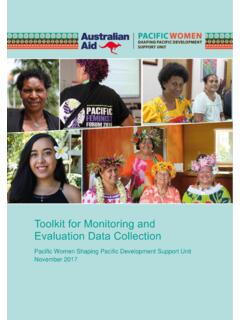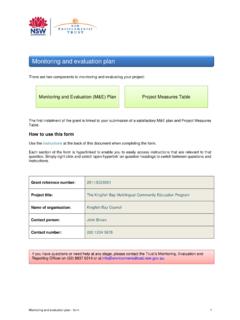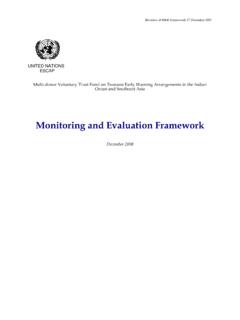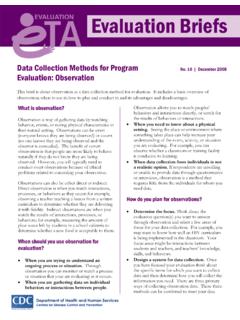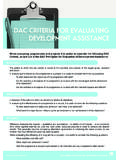Transcription of MONITORING, EVALUATION AND LEARNING (MEL) GUIDE
1 1 monitoring , EVALUATION AND LEARNING (MEL) GUIDE Using MEL to strengthen your organisational effectiveness 2 Contents Introduction .. 3 What is MEL .. 4 Organisational MEL .. 5 Project MEL .. 5 The monitoring , EVALUATION and LEARNING cycle .. 7 Planning for MEL .. 8 Key Elements of MEL .. 9 MEL Planning Tools .. 10 Data .. 13 Types of data .. 13 Sources of data .. 13 Methods for data collection .. 14 Ensuring quality of data .. 14 MEL In Practice .. 16 Who should be involved in your MEL work? .. 16 Who will manage or oversee MEL? .. 16 How much will your MEL cost? .. 16 How much time might it take? .. 17 Working well with consultants .. 17 LEARNING .. 17 How can you develop your organisations skills further? .. 18 Resources .. 19 TEMPLATE PLANNING MEL .. 21 3 Introduction This MEL GUIDE has been developed to support your international development organisation to increase knowledge, confidence and success in monitoring , EVALUATION and LEARNING (MEL).
2 It aims to strengthen your organisational MEL practices; enhance your capacity to become more effective; and maximise your impact; through review and LEARNING with partners and the communities you work with. Additionally, it will equip your organisation to meet funders requirements on MEL. In this GUIDE , you will find answers to questions like: Why is MEL important? What are the benefits of MEL to project stakeholders? What is the difference between organisational MEL and project MEL and why are they both important? What is the MEL cycle? What are the steps for developing a MEL plan? Who should be involved in MEL planning and implementation? How do you collect data? What do you do with the data collected? This GUIDE will be useful to your organisation in two main ways. If your organisation is new to MEL - it will walk you through the steps for setting up and implementing MEL systems for your projects.
3 If you already have a MEL system in place, it will GUIDE you to review and improve the MEL systems you already have in place. In either case, this GUIDE will support your organisation s efforts to monitor, evaluate and learn from your project activities and results to enhance your effectiveness and impact. You do not need to read this GUIDE from cover to cover. The table of contents will GUIDE you to sections that may address your specific needs. It is however recommended that you read section 2 if your organisation is new to MEL. 4 What is MEL Let s begin by defining the basic terms in this concept. Table 1: MEL explained What is it? monitoring monitoring refers to the routine monitoring of project resources, activities and results, and analysis of the information to GUIDE project implementation. EVALUATION EVALUATION refers to the periodic (mid-term, final) assessment and analysis of an on-going or completed project LEARNING LEARNING is the process through which information generated from M&E is reflected upon and intentionally used to continuously improve a project s ability to achieve results.
4 monitoring and EVALUATION can help you to work out what difference you make through your projects. Your organisation and partners can then go on and learn from this to improve your performance in future. MEL activity may already be taking place in your organisation; this GUIDE will help you to take stock of what you are already doing, put plans and systems in place and learn from it. MEL can sometimes be thought of as activity we do to allow us to report to our funder, while this is true, a good MEL system can be so much more. Table 2: Who is MEL for? Stakeholder Benefits of MEL Your organisation MEL helps your organisation answer questions like: - Are you on track to achieve your mission? - Is what you are doing contributing to the long term change your organisation is trying to create? - Are your project activities are on track? - Are your partners activities are on track? - Is your intervention reaching target communities?
5 - Are target communities experiencing anticipated changes as a result of your project? - Are there any challenges to address; - What is working well, what is not and why, and what could be done differently? Your partners MEL helps your partners answer questions like: - Are their activities on track? - Are their activities reaching target communities? - Are communities experiencing anticipated changes as a result of the project? - Are there any challenges to address? - What is working well, what is not and why, and what could be done differently? Communities you work with MEL enables communities to: - provide critical information on their needs, abilities and capacities - input into the project design - reflect on their participation in project activities - scrutinize how the project or the organisation is operating - provide information on how the project is affecting them and changing 5 their lives - participate in reflecting on project achievements - provide recommendations for how to improve project achievements.
6 Your funders MEL allows funders to understand: - how the funds committed are used - whether funds are spent on identified needs - whether strategies to address needs are appropriate - who benefited from project activities and outputs - whether lives are changed as a result of the project - whether the changes will last after the project ends Ensuring that the needs of and benefits for each stakeholder in MEL is carefully considered makes your organisation accountable There are two levels of MEL, organisational MEL and project MEL. Organisational MEL At the organisational level, your MEL will focus on monitoring the performance of your organisation as a whole. The areas considered in organisational MEL include: Your organisation s mission; Your organisational structure; Your planning, implementation and MEL processes; The relevance of your projects to your mission; and Your organisational capacity. Project MEL1 Project MEL focuses on the following for the specific project: monitoring targets results changes challenges 1 Due to the target audience of this GUIDE we will refer to projects as a unit of intervention.
7 Larger organisations may look at MEL from a programme perspective and terminology may differ between organisations. Organisation X s mission is to create and promote opportunities for girls to become empowered (personally, socially and economically) in order to be able to contribute to the development of their communities. Organisational MEL should include: how your projects meet the needs of communities you work with, and how this relates to your mission whether your organisational structure and roles allow you to implement girls empowerment activities what systems are in place for project planning implementation and MEL, and how effective they are your organisation s capacity (staff capacity, funding, partnerships, networks) to achieve your mission. 6 This GUIDE focuses mainly on Project MEL, but the tools can equally be applied to the organisational level. There are however, many other tools that can be used for organisational level MEL.
8 Resources and guidance on organisational MEL can be found in the resources section. MEL for advocacy MEL can provide critical information for your advocacy work on behalf of target communities. This includes information on the needs of target communities as well as the changes they experience as a result of specific projects. Normally this has the objective of developing new partnerships or obtaining more funding. MEL of Advocacy efforts is a specialised topic which is not covered in this GUIDE . You will find links to more information on this topic in the resources section. 7 MEL: the basics The monitoring , EVALUATION and LEARNING cycle MEL is an integral part of project design, implementation and completion; MEL is done at all stages within the project cycle The MEL cycle helps you to position MEL in the life of your project, as shown on the diagram below. Figure 1: The MEL cycle * There is no one generic project cycle and associated MEL activities.
9 This figure is one way of showing this. The MEL cycle starts with the initial needs assessment, this is when you identify a particular need or problem in a specific community which your organisation is able to address. Ideas are generated by LEARNING from existing projects, projects which have ended or simply through conversations with partners, communities and funders. Then you develop an in depth understanding of the need or problem, its underlying causes, and how it affects the target communities. This is also the stage to think through potential solutions with your partners and target communities. Having identified a need you then need to design a project. The project will be the most credible intervention to address the problem. A critical stage in the MEL cycle is MEL planning. This is where you, in collaboration with your partners and target communities, decide the main MEL activities.
10 You then go on to put in place a realistic plan for undertaking them. MEL planning is a critical stage in the MEL cycle where you should consider planning for the following MEL activities: conducting a baseline, undertaking routine monitoring , undertaking mid-term and final evaluations; deciding how to go about reflecting on information and LEARNING from it to improve project performance. 8 During project implementation monitoring will be an ongoing process. You should allow time for MEL activities in staff workplans and timetable regular checks with partners to ensure monitoring is taking place. It is also recommended that you conduct a mid-term EVALUATION . This allows you to take stock of where your project is and whether you are on target to achieve project outcomes. At the completion of your project a final EVALUATION should be conducted. This is the stage of the MEL cycle when you evaluate, in collaboration with your partners and communities, whether your project brought about any real change in the lives of the communities you work with.
